Benching 101
You're in your car on the way to work in the morning, or maybe you're on your way to a friend's house in a not-so-good part of town. In order to reach your destination, you have to cross the railroad tracks. Eventually you're going to get caught waiting for a train to pass. When this happens, what do you do? Do you curse under your breath and drum your fingers impatiently on the steering wheel until the gates go up? Do you make a U-turn and try to race the train to another intersection so you can cross more quickly? Maybe you just close your eyes and listen to the radio as the train passes in front of you...
I grab my camera, open the door and start snapping pictures. I am what some people refer to as a "rail fan." That geeky subculture of people who identify engines and boxcars by their numbers and then track them across North America (or whatever continent you happen to be from). I'm not too interested in the coalers, hoppers, gondolas and autoracks though. I'm interested in what has been written on the side of them. The aerosol streaks, the giant names and pictures painted onto the side of the boxcar, the tiny oilbar monikers scribbled by linemen, hobos and taggers. The names tell you more about the train than any number log can do. It tells you who has touched the car, who has worked on the train, the people who have stood out all day in the heat and cold, humping train-cars and occasionally leaving their mark. The teens and adults who hop fences to get into trainyards in the dead of night to leave pieces of art that will travel the country for years and years. Hobos, vagabonds and thrill-seekers who travel from state to state while sitting on the tiny platform in front of a grain-hopper, or tucked away inside a boxcar, hoping not to be seen by the cops or the railyard cops ( a.k.a. bulls). People of all ages, backgrounds and lifestyles. Even people like me.
I engage in a practice that is referred to as "Benching." All you need to go benching is a love for trains, and a keen eye for art and authority figures. Some railroad workers don't appreciate the general public wandering around in their yards. There's a good reason for this. Quite a few idiots get killed every year when they wander behind or under a train while the cars are being humped (hooked together by the engine, usually done at speeds of up to 15 mph). If you live near a yard, you've heard the booming sounds of boxcars being slammed together at all hours of the night. Some cars are released far up the track, and can glide silently for hundreds of yards and take you out with no warning at all. If you're standing between tracks and a train comes around a corner, it can lean precariously towards you, or loose debris or strapping might be dragged along side of the train, creating a razor-sharp metal whip. There are dozens of ways to be killed, maimed, crushed, hurt, ticketed, or arrested if you spend enough time near the tracks. So unless you're familiar with the noises that trains make (powering up, airing up the brakes, releasing hoses, etc.), I wouldn't advise walking around in a trainyard, even at night when things seem quiet.
That being said, I enjoy hanging out in trainyards, even at night when things seem quiet.
Benching is looking for and identifying graffiti and matching it up with the artist who created it. There are dozens of message-boards devoted to this hobby, and Flickr has a thriving scene of people who trade hard-copies of photos and track specific pieces on their journey across the country. There are different types of artwork to be found on trains, and I'm going to introduce you to a few of them.
Monikers and Streaks: Monikers are quick pieces that are done with paint pens, oilbars, chalk, aerosol and other mediums. They tend to be caricatures, initials or "tags" that have been perfected over time so that they can be quickly applied. Linemen used to pass messages along via boxcar to one another, and some people came up with their own specific drawing to include with every message. Taggers leave monikers when spray-paint is scarce and when the yard is too hot to spend the time putting up a full piece. Train-hoppers add messages while riding the rails, writing down which state they are in, the date or the miles traveled and sometimes a message to others. Some people just like to add something to a train that might be seen by dozens of other people. Everyone has a different reason.
There really aren't too many sources of information on artist's monikers out there on the internet, so tracking down something new or deciphering a tag might take months. Sometimes a person's moniker is known under 5 or 6 different names, just because they leave a drawing with no real identifying information included. Anonymity in order to gain fame is juxtaposed idea, but fairly common. One thing I have learned is that rail-fans can be very hardcore at times. While some people really enjoy sharing their findings with others, there are some people who can become quite upset if you incorrectly label a moniker or include faulty information with the description (believe me, I know). So I am going to just give a brief description of the following artists, and leave further research up to you, if you remain interested.
The most common monikers you will run across are from people who have been doing this for years and years. Trains don't get buffed or cleaned as much as city walls do, so while a graffiti piece on the side of a building might only stay up for a weekend and be seen by a few hundred people, pieces on trains can travel around for decades, sometimes untouched until they fade into obscurity or are gone over by another artist.
Colossus of Roads:
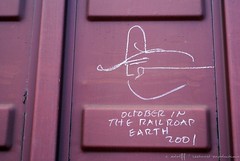
The Solo Artist:

Whistle Blower:
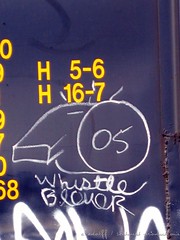
North Bank Fred:

Smokin' Joe:
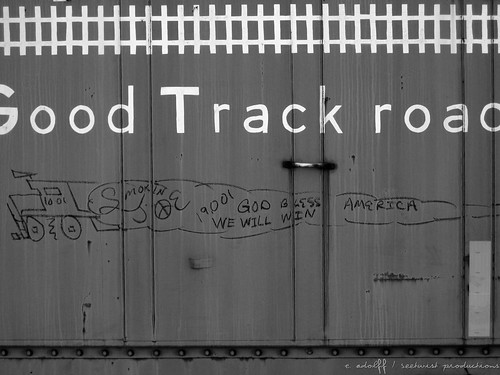
Virginia Zeke:

There are others that have been around for decades and decades. Herby, Bozo Texino, Skysail Jack (Jack London's moniker)... Colossus of Roads has been at it for over 40 years now, and some of the original "Kilroy Was Here" monikers date back to World War II. These are the pieces of the train that convey history and tell you a bit about who has been near or on it throughout history. Unfortunately, this type of art is being recklessly replaced by another type. Aerosol Art.
The second type of train art is the big stuff that you're more likely to catch it as it rolls in front of you. This is done by artists who range from their pre-teens to some who are in their 40's and 50's. The game is to get up as often as possible. There are hundreds of thousands of boxcars, coalers, tankers and other types of freights cruising from coast-to-coast on a daily basis, so the more you hit, the more likely it is that you'll be seen and recognized by others. Some people incorporate characters or identifying writing styles. Some people change their style every time. Sometimes groups of people go out and cover a car from end-to-end, or bring rollers to cover a "whole car".
Yards are highly prized and not easy to come by in some cities. Getting busted in a yard that other painters use can easily start fights between crews, leading painters to diss each other's work (going over the piece with streaks of paint or insults). Some cities have a more chill environment. There's little or no beef between crews, relaxed and secluded painting spots with no security patrols, etc. Yard workers also have mixed opinions on train art. Some don't want people in the yard at all and will employ bulls to patrol the area, making sure nobody is vandalizing the area. Sometimes it's for safety reasons, sometimes they just don't want to deal with the mess that some painters leave behind. Other workers have no problem with the art, unless it obscures their numbers. Seasoned artists will do their piece around the numbers, or bring stencils to replace them over the top when they are done. It also increases the likelihood of their work staying up for a longer period of time:

Here's a small sample of some of the art I have come across while benching. It's a rarity to find a car that doesn't have at least some sort of tag on it, and most will have at least 1 or 2 small monikers on the endcaps.
Throw / Fill

Done quickly and usually with 1 or 2 colors, this is the quickest way to get up on a train. Some 3D effects may exist, but it's usually just an outline of the artist's name, initials or group, left hollow or filled in with a second color.
Piece
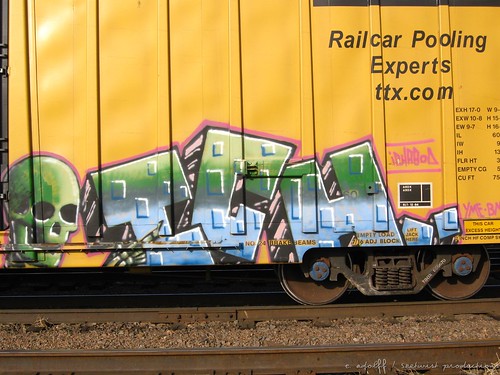
3 or more colors, this is something that can take some planning and a few hours in the yard to complete. Sometimes sketched out beforehand, this actually takes quite a bit of talent due to layering colors and outlining.
Group Effort:
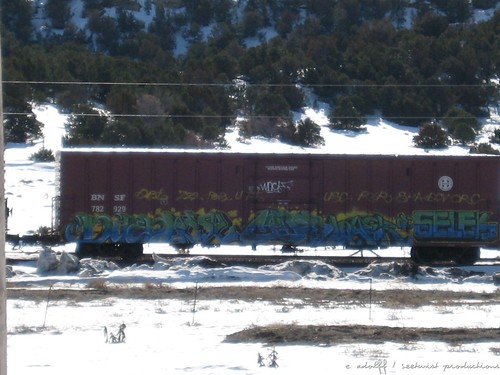
Most or all of the people in a crew going out to cover a train at the same time. More painters = larger pieces and more attention.
End-to-end (e2e)
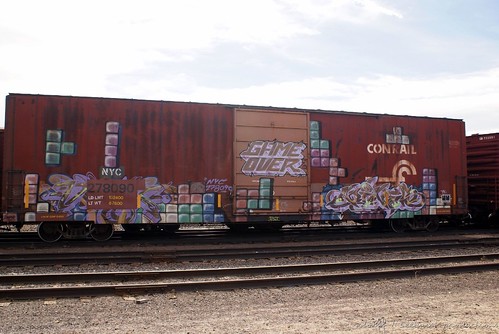
Paint from one end of the car to the other end. Sometimes done by a group, sometimes done by one ambitious person with a lot of time and a lot of paint.
Whole Car
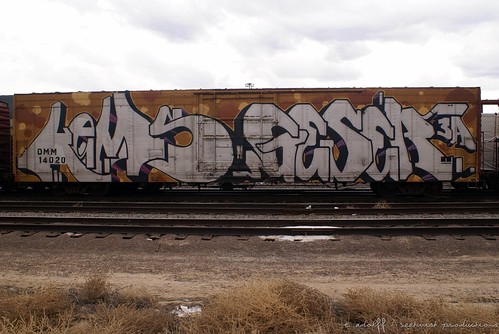
Sometimes done with paint and rollers instead of aerosol, the idea is to cover every single inch with paint. Due to their smooth surfaces, I tend to find Whole Cars done on auto-racks more often than any other type of car.
Now, I don't expect everyone who reads this to go out and start photographing trains. But the next time you're stuck at a light and you see those cars go rumbling by, take a moment to check out what's on the side. Some of the best art out there isn't found in galleries. It's rolling across the country right now.
*Many thanks to my Flickr contacts who have been beyond helpful when it comes to deciphering and discussing the origins behind rail art.

